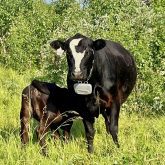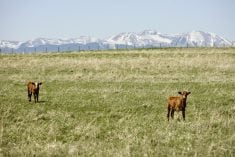Lupine calves” or “crooked calves” are an example of what can happen when various plant toxins are ingested by a pregnant cow at a certain stage of pregnancy.
Lupines, also known as bluebonnets, are legumes. As legumes, they can enrich nitrogen-poor soil. In Canada, at least 28 species have been recognized, mostly in Western Canada. A couple of them grow as far north as the western Arctic. Some grow in southern Ontario and Eastern Canada. The blooms may be blue, yellow, pink or white, and some have been cultivated as garden flowers. Some cultivated lupines have escaped and spread, growing along roadsides. Some species are grown for green manure, and as a cover crop in reforestation projects.
But while lupines are known for their beauty and nitrogen-fixing powers, they can cause trouble on the range. Their toxins can create malformations in the developing fetus. Some types of lupines are more toxic than others.
Read Also

Canadian Beef Check-Off Agency reports on investments and activities
The check-off agency’s work behind the scenes is what ensures cattle check-off dollars are invested wisely, accounted for transparently and deliver measurable value back to producers and importers.
Often the legs of affected calves are crooked or the joints are fused, so the legs don’t move or bend properly, which can become a problem during birth. Most of these calves can be delivered through the birth canal — unless the deformity is too severe. In those situations, the calf must be surgically removed by C-section, though sometimes a veterinarian will opt to cut up the calf in the uterus and bring it out vaginally in pieces.
These defects are caused by certain alkaloids if the cow eats lupine between 40- and 70-days gestation. The alkaloids affect the calf’s brain and act as a sedative, and the sedated fetus isn’t moving enough. The legs and joints become stiff or fixed.
- Read more: Limb problems in newborn calves
As stated by Dr. David Steffen, diagnostic pathologist and professor at the University of Nebraska School of Veterinary Medicine, most of the fetus’s body structures are formed during early gestation, so this is when they can be adversely affected.
For example, the palate at the roof of the mouth closes at about 55 to 60 days of gestation. If the fetus is affected by lupine at that point, the tongue doesn’t move, forming a physical obstruction as the palate plates move toward one another. The tongue prevents the plates from fusing, creating a cleft palate, Steffen explains.
Lupine isn’t the only plant that can cause such defects. Steffen says plants such as hemlock can affect the developing calf’s nervous system, leading to crooked legs and cleft palate.
“In order for the legs and joints to be mobile and develop normally, there must be an intact nervous system — both from an anatomic and a functional standpoint.” Similar to a person having a spinal injury or a nerve injury in the arm or leg, anything farther from the body at that point will contract as the muscles atrophy, he says.
If there is no motion during development, the joints tend to become fixed, Steffen explains. While it’s not always known why a calf is born with crooked legs or fused joints, often plant toxins are suspected, especially if the cows were grazing pastures containing lupine during early pregnancy.
Dr. Barry Blakley, toxicologist with the Western College of Veterinary Medicine, says several factors may result in plant poisoning. Overgrazing is one, as cattle may be forced to eat toxic plants after they’ve eaten all the good plants.
“In certain parts of North America this is a big issue, with some deformed calves born nearly every year, and in other areas stockmen have never heard of this problem,” he says.
Lupines are also fairly nutritious, so cattle don’t necessarily avoid them.
Lupines in Idaho
Many ranchers in Lemhi County, Idaho, had the heartbreaking experience of a much higher incidence of crooked calves in the spring of 2021, due to an abundance of lupine on summer range pastures the year before.

Dr. Robert Cope, a veterinarian in Salmon, Idaho, for the past 46 years, has seen many cases of crooked calves and other birth defects caused by lupine, but 2021 was one of the worst for ranchers in this valley.
“The bad news is that lupine is not the only plant out there that has alkaloids that can severely affect the fetus. I have seen crooked calves from cows that came off pastures that I know did not have lupine.”
Whatever the plant, if it contains toxic alkaloids and the cow eats enough of it at the right stage of pregnancy, defects will result, he says. The effects may be mild — just a slight deformity in a joint or two — or so severe that the calf cannot survive or must be humanely destroyed.
“I also think that some of the schistosomus reflexus calves — with internal organs on the outside of the body — may be caused by lupine,” Cope says.
“The fetus is formed in reverse of how it should be; instead of having the back arched, it is folded the other way, with all four feet and the head pointed in one direction and the guts hanging out the other side. I am convinced that lupine can cause this deformity as well as causing calves with crooked joints because some of these cases occur in herds that also have lupine deformities,” he says.
“One rancher in our valley is also convinced of this because when he was ranching earlier in the rugged range country in northwestern Montana, in 1981 their veterinarian in that area had to deal with about 14 of those abnormal calves. That was the calving season following the Mount St. Helens eruption in 1980. He said that when they turned the cattle out on the range that year the ash was so thick over everything that the only plants sticking up through it was lupine. That next spring, they had a huge number of deformed calves,” Cope says.
The lupine is toxic all summer long, but once the cows are past three months of pregnancy it doesn’t matter. The only way to prevent problems is to avoid turning cows on lupine-containing pastures until they are past 90 days of pregnancy, or breed them earlier, Cope says. This would mean holding April-May bred cows off mountain pastures until late July or August, or calving in the fall and breeding in December. Lupine can be safely grazed by at-risk pregnant cattle in the fall after the pods have released their seeds.
Some of the ranchers in Lemhi County, Idaho, are considering going to fall calving to try to avoid the problem, and some hope they can work out a change of timing on their use of leased public land allotments, grazing them later in the year rather than in the spring. There is no way to get rid of the lupine because it is a hardy native plant and grows nearly everywhere. On public land, it is illegal to spray native plants.
“When spring weather is cool and moist it can be a wonderful year for grass, but also for lupine,” Cope says. “There are two kinds of lupine in our region, but they both impact the fetus.”
As Mark Twain said about the weather, “Everybody talks about it but there’s not much you can do about it,” says Cope. c
Heather Smith Thomas raises beef cattle with her husband on their ranch in Idaho. She also writes articles for ag publications as well as books on horse care and cattle management.
















